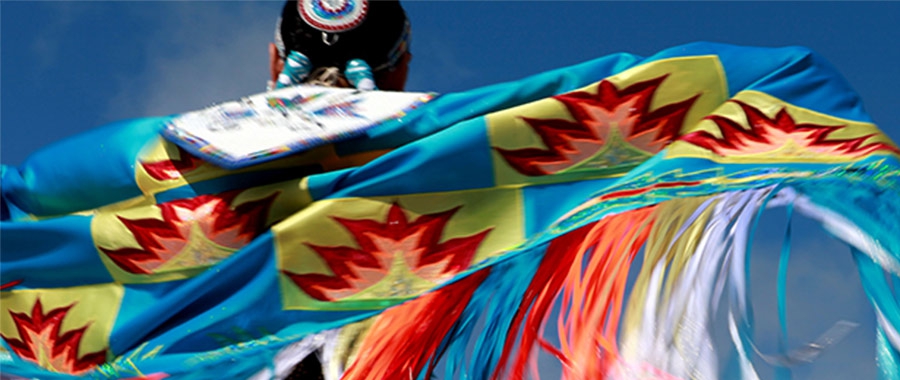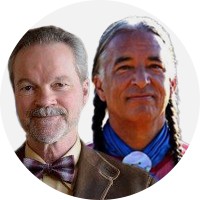The views expressed in our content reflect individual perspectives and do not represent the authoritative views of the Baha'i Faith.
It turns out that other Faiths beyond Judaism and Christianity contain ten commandments for living a spiritual life—including the Lakota belief system brought by White Buffalo Calf Woman.
In this continuation of the BahaiTeachings.org conversation between authors Christopher Buck and Lakota Baha’i Kevin Locke, we learn more about those commandments and their relevance to daily life in the modern world:
Q: Kevin, can you elaborate on White Buffalo Calf Woman’s “Ten Commandments?” Would you please comment on each? How do the Lakota people put White Buffalo Calf Woman’s “Ten Commandments” into practice and keep them alive today?
A: Here’s what I know, having been born and raised in the Lakota sacred tradition—and having later become a Baha’i, while walking both the Lakota and Baha’i pathways as one:

White Buffalo Calf Woman
Possess “great respect and reverence toward sacred things.” The Lakota do differentiate between the sacred and the mundane. The appearance and message associated with White Buffalo Calf Woman is the flash point. Everything takes on meaning and becomes sacred in the context of her revivifying and renewing message and presence. Each ceremony associated with White Buffalo Calf Woman’s teachings invokes her divine presence, whereby participants are mystically and spiritually transported to that sacred, placeless and timeless realm, sanctified from this world.
The sacred pipe that White Buffalo Calf Woman brought is the symbol and touchstone of her dispensation and through it all things are made sacred. Her teachings and ceremonies recreate and invoke her holy manifestation from the sacred, heavenly realms to this physical semblance of reality. As a part of the “Prophetic Cycle,” moreover, White Buffalo Calf Woman foretold the appearance of Tȟuŋkašila / Grandfather (Baha’u’llah) — as the one Who will bring the sacred and mundane together and lead all the peoples of the world to the “Red Road.”
- Live as “belonging to one family.” The most important phrase associated with White Buffalo Calf Woman is “mitákuye oyás’iŋ,” which means “all my relations.” Every prayer and benediction is solemnized with this testimony affirming the relatedness of all things physical, spiritual, living or dead, animate or inanimate. It is the affirmation that all things are of God and therefore interrelated.
- Be “always very faithful to promises.” In the Lakota oral tradition, the spoken word is paramount. It is intensified and imbued with power and potency. Throughout the northern plains, one can find hand shapes deeply etched on granite boulders wrought by the ancient holy ones. Prayers and pledges are made by fitting one’s hand within these ancient petroglyphs and intoning one’s prayers and invocations. The boulders bearing these ancient petroglyphs stand throughout eternity and bear witness to one’s sincerity throughout these worlds and all the worlds beyond. This is symbolic of the belief that all of creation bears continual witness to all of one’s words and deeds. In a famous song regarding the omniscience of creation, the eagle from the apex of the physical realm says; “ognáš mayágnaye kiló” = “Don’t you dare try to deceive me!”
- “Cease hostilities against other nations.” One of the devotional practices ordained by White Buffalo Calf Woman is the Huŋká or Huŋkákičiyapi = “The Making of Relatives.” Through visions and divine guidance, it was originally instituted to solemnify enduring peace between the Lakota and Arikara, two formerly mortal tribal enemies. The Huŋká is also called the “Corn Dance” because the corn represents the seed of faith that is planted, then sprouts, grows, flourishes and matures—the fruit of which is the peace and holy love planted in the hearts of the formerly rival and mutually averse nations. This “Corn Dance” ceremony represents the Divine Will for peace and reconciliation between hostile nations and factions.
- “Administer help to the sick.” The hoop of holiness and love—demarcated through the teachings of White Buffalo Calf Woman—represents wholeness and well-being in which all are interconnected and interrelated by bonds of love and concern. No one can be excluded or left out of this hoop. Any who are sick or ailing must be attended to and restored to wholeness and well-being.
- “Comfort others in time of sorrow.” One of the expressions of White Buffalo Calf Woman’s injunction to be loving and compassionate is wašígla wolwíčhak’u = “Feeding the Mourners.” This involves the compassionate and magnanimous act of one group endeavoring to release an individual or family from their grief by hosting a public feast and gathering to condole and to officially entreat the mourners to put aside their mourning and bring their heart and soul back in to the community. This “Feeding the Mourners” ceremony involves prayers, speaking words of comfort and condolence, presenting gifts, offering food and love to mend the broken-hearted. This type of expression pervades the traditional Lakota culture and is the direct result, expression and enactment of White Buffalo Calf Woman’s divine counsel.
- Show “kindness toward every living creature on earth.” A devotional song associated with White Buffalo Calf Woman states:
“Tȟuŋkášila waŋmáyaŋka yo! Makȟáta táku wakȟáŋ mayák’upi čha, henáke tȟaŋíŋyaŋ ye čhe tȟaŋíŋyaŋ yaúŋkte. Lehápi čha létu nuŋwé” – in English it means “Grandfather behold me! All sacredness upon the earth you have bestowed upon us. Through all of these Your holiness is revealed to us. This you have ordained. Thus it shall be.”
The kindness shown toward everything on earth results from the understanding that everything is a physical manifestation of spiritual reality, exemplifying the truth that both the seen and the unseen, the physical and spiritual worlds are the handiwork of the one Creator, Whose laws pervade the entirety of His creation. Thus everything in this physical world is a counterpart of something in the spiritual realms. Kindness, respect, reverence and awe are accorded everything in this world which, in reality, is a portal to ineffable, divine mysteries.
- “Remember the dead.” “Wanáǧi Gluhápi” = “Keeping of the Soul,” one of the devotional practices established by White Buffalo Calf Woman, is the symbolic keeping of a departed loved one’s spirit in order to draw the physical and spiritual worlds together in the heart of the people. This devotional practice prescribes that the family of the departed loved one dedicate a year or several years, or even a lifetime to perform good deeds and virtuous, magnanimous acts in the name of the loved one in order to further their progress on the path to eternity.
- “Love your children dearly.” The Huŋká (= “Making of Relatives” or “Corn Ceremony” mentioned in #4 above) especially involves children. A family who wishes divine blessings to descend upon their child will identify an individual from a foreign community to become a godparent for their child. Thus the child becomes the axis of love around which the enduring spiritual peace, amity and accord is created. The child becomes “hokšíčhaŋlkiyapi” = “a child whom they use for a heart,” often understood as “beloved child.” The solemnizing act is the Corn Dance, in which it is the child who represents the corn which, when nurtured and treated tenderly—receiving the spiritual equivalent of rain, sun, and gentle breeze (all symbolic of the manifestations of love that must needs be shown the child)—will grow and its fruit will bring nourishment and blessings to the people.
- “Above all, lead pure lives.” Perhaps the most important admonition of White Buffalo Calf Woman was to moral rectitude and to lead pure, upright lives. At the same time the principle of cleansing and transformation was also enjoined.
Q: This is profound! I hear White Buffalo Calf Woman’s voice enthrall, echo, resound and reverberate in this clarion call of Baha’u’llah:
The well-being of mankind, its peace and security, are unattainable unless and until its unity is firmly established. This unity can never be achieved so long as the counsels which the Pen of the Most High hath revealed are suffered to pass unheeded. …
One righteous act is endowed with a potency that can so elevate the dust as to cause it to pass beyond the heaven of heavens. …
Be pure, O people of God, be pure; be righteous, be righteous …. Say: O people of God! That which can ensure the victory of Him Who is the Eternal Truth, His hosts and helpers on earth, have been set down in the sacred Books and Scriptures, and are as clear and manifest as the sun. – Baha’u’llah, Gleanings from the Writings of Baha’u’llah, pp. 286–287.
















Comments
Sign in or create an account
Continue with Googleor